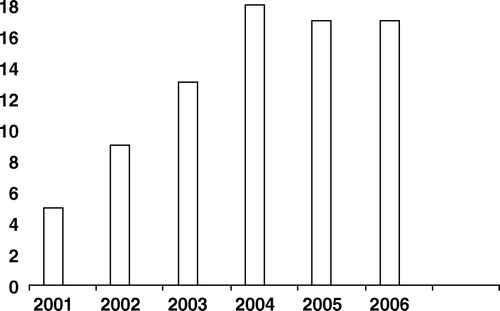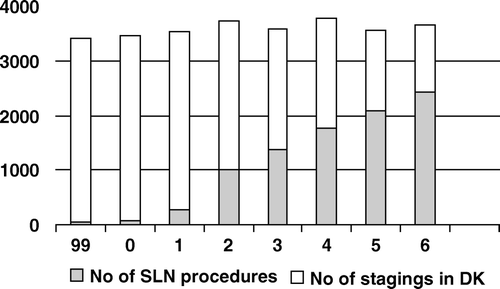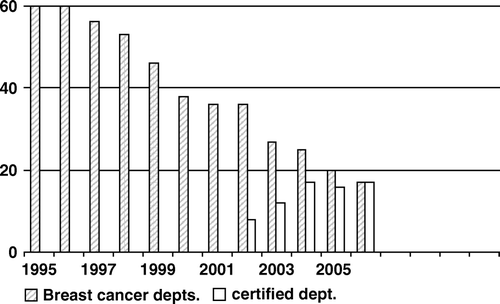Abstract
Prior to the initiation of a nationwide study of the sentinel node staging technique the Danish Breast Cancer Cooperative Group (DBCG) defined a set of minimum requirements to be met by surgical departments before they could include patients in the study. The requirements specified a minimum patient load in the individual surgical unit, a minimum surgical training in the sentinel node biopsy technique and a minimum quality outcome in a validating learning series of SNLB procedures. A working group assisted departments in meeting these terms and later audited and certified departments before they could include patients into the study.
As a result of this strategy the sentinel lymph node staging was fully implemented in all Danish surgical breast cancer centres within three years and all sentinel node biopsies in the period were recorded in the DBCG data centre. Furthermore, the strategy accelerated the ongoing process of centralizing breast surgery in specialized departments.
In January 2002 The Danish Breast Cancer Cooperative Group (DBCG) introduced a nationwide open observational study of the sentinel node axillary staging procedure (SLNB) in patients with primary breast cancer.
The DBCG systematically collects data on all Danish breast cancer patients. For almost three decades the organization has issued and continuously updated national Danish guidelines for the diagnosis, treatment and follow-up of patients with breast cancer. DBCG recommendations are accepted and adhered to by all Danish surgical departments involved in breast cancer treatment. National guidelines from the DBCG for SLNB were consequently an expected continuation of well-established traditions.
The aim of the study was to collect detailed data for an evaluation of the SNLB technique and at the same time the DBCG hoped for a nationwide swift and controlled implementation of the SNLB technique in all breast cancer centers. For that purpose the DBCG defined a program to facilitate the implementation of the SNLB technique and also specified a number of requirements to be met before departments could abandon conventional axillary lymph node dissection (ALDN) and enter patients into the study.
The SLNB study and the implementation program were published in January 2002. In the present paper we report and evaluate the organization and progression of the nationwide introduction of the SLNB technique in Danish breast cancer centers, as well as the reorganization of Danish breast cancer surgery that was catalyzed by the implementation. Disease specific results from the initial five years experience with SLNB in Denmark are published elsewhere Citation[1].
Preparations for the study
Prior to the publication of the SNLB protocol, the Surgical Scientific Committee of the DBCG debated and agreed upon the protocol and not least the conditions to be met by surgical departments wanting to participate in the study. All counties in Denmark are represented in this committee. Accordingly, the future terms to qualify for participation were well known in all departments treating breast cancer long before the final approval by the committee and several departments prepared to meet the terms before the publication of the study. In order to assist departments preparing to qualify, the DBCG early in the spring 2001 formed a working group with representatives from four breast cancer centers. These four centers had performed validating SLNB's procedures since 1997 and had already abandoned ALND in SLNB negative patients, or were ready to do so Citation[2–4].
The DBCG working group was furthermore authorized by the DBCG to audit a series of learning operations in each surgical department and to certify departments who fulfilled the standards defined by the DBCG.
The four departments represented in the working group all had experience from a total of 530 validating SNLB procedures, and it was decided by the DBCG to consider these four breast centers as fully certified, a decision that was approved by all surgical members of the DBCG.
The criteria to be met by each surgical department to become certified to enter patients included:
A minimum of 30 SLN procedures per year requiring a patient flow of at least 80–100 primary breast cancer operations annually.
A learning series of at least 30 SLNB procedures with ALND as control.
A minimum detection rate of 80% in these learning procedures and no more than one false negative procedure was accepted. If the criteria were not met in the latest 30 procedures, the learning series was extended by ten procedures until the criteria were met in the latest 30 procedures.
An external audit to be performed by representatives from the DBCG of the latest 30 consecutive learning SLNB with conventional backup dissection in each center.
Furthermore, case report forms stating details in methods and results of all SLNB, including learning operations, were to be submitted to the DBCG data center.
The strategy of defining national requirements, minimum experience and quality standards to be met and documented by surgical departments before full implementation of a new surgical technique is accepted, was new and remarkable as it was not based on any legislative authority, but depended entirely on the acceptance by all breast centers that the demands were essential to minimize the risk of an increase in false negative staging.
Progression of the implementation of the SLN staging technique
Surgical departments were certified from November 2001 until October 2004. During this period 13 public breast cancer centers were audited and certified to include patients in the SLNB study ().
Table I. Frequency of ALND and SLNB in Denmark 2001–2006.
One department, on its own initiative, stopped treating breast cancer patients after being certified, as the patient flow did not comply with the minimum DBCG demands (). SNLB was thus performed in 16 public certified breast centers after the implementation period.
Two departments initiated learning programs, but never completed the initial 30 learning operations with backup dissection and stopped treating breast cancer patients.
One private hospital started SNLB without being certified by the DBCG, but adhered in all other respects to DBCG guidelines. The operating surgeon had his principal engagement in a certified public breast cancer center.
A total of 423 SNLB procedures with completion ALDN were reported from 13 departments before certification was granted by the DBCG.
In Denmark 3500–3800 women were diagnosed with primary breast cancer annually. In 2001 31% of all Danish breast cancer patients were operated in centers certified for SLNB by the DBCG (). Four years later, in 2005, 97% of all breast cancer patients were operated in certified departments and five years after the initiation of the study 66% of all staging procedures in Denmark were performed as SLN biopsies ().
Figure 2. Fraction of axillary staging operations in Denmark performed in certified Centers1999–2006 in women with primary breast cancer.
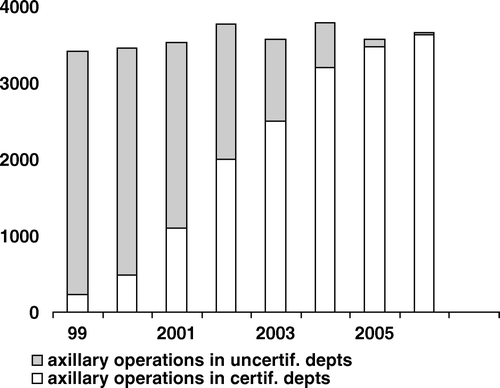
Immediately after being certified, the individual department applied the SLNB technique in 43% of all staging procedures increasing to 67% during the following 3 to 4 years ().
Figure 4. Number of SNLB compared to all axillary staging operations in certified departments 1999–2006.
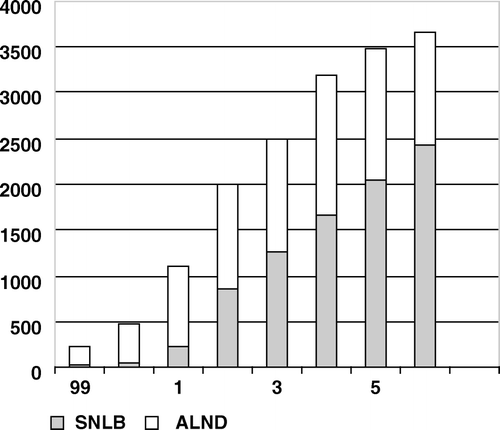
In the years preceding the SLNB study breast cancer patients in Denmark were operated by general surgeons in a large number of surgical departments. In 1996 the DBCG data center received case report forms from 60 different departments operating breast cancer. As the certification process began in 2 001 breast cancer operations were performed in 36 departments, but five years later another 20 departments had stopped treating breast cancer leaving 16 certified public departments and one private hospital operating patients with primary breast cancer () after implementation was completed.
Discussion
The implementation of new surgical techniques with major hypothetical benefits to patients presents a number of ethical problems. On one hand all patients expect to benefit from the latest research developments the moment results are published. On the other hand, possible contraindications, benefits, risks and side effects are poorly documented and application of the methods requires a minimum of surgical training and experience to equal results achieved in published treatment series from dedicated specialized centers.
In Denmark no legislation exists to regulate or monitor the implementation of new therapeutic technologies or principles, and methods and criteria for implementation depends on individual local institutions or departments.
Furthermore, several early studies of the sentinel node concept Citation[5–9] emphasized the importance of initial training of surgeons through series of validating operations as well as the importance of documenting results before completion ALDN could safely be abandoned in SLNB negative patients. Optimal experience, however, and minimum criteria to be obtained before a negative SLN could be relied upon, had not been defined.
Although one purpose of the DBCG is to ensure optimal diagnosis and treatment of patients with operable primary breast cancer through national clinical guidelines, the only authority of the organization depends on the voluntary participation of the individual clinical department.
The essential purposes of the DBCG demands were evidently to minimize the risk of an increase in false negative rate and to achieve an acceptable detection rate, but in addition it was essential to ensure national acceptance of the demands from all departments operating breast cancer patients in order to maintain the national data collection from all breast cancer operations in Denmark.
On these premises the executive committee of the DBCG decided to provide assistance to surgical departments implementing the SNLB and, within the frames of a study, to introduce national criteria for employing the SNLB technique, that not only defined minimum quality standards to be complied with, but also specified a minimum annual volume of operations to be performed in the individual surgical department. In addition, a certification process including an external audit of an initial series of learning operations in each department was introduced.
During the years preceding the DBCG approval of the SNLB study several reports Citation[10], Citation[11] demonstrated better survival after treatment in centers specialized in breast cancer surgery. Recommendations had advocated that breast cancer surgery should be centralized in departments with more than 150 operations per year, and that operations should be performed by surgeons dedicated to and specialized in breast cancer treatment Citation[12–14]. These recommendations had already resulted in a reduction in the number of departments performing breast cancer surgery in Denmark from 60 departments in 1996 to 36 in 2001 (), but still 18 of these 36 departments treated less than 100 patients with primary breast cancer annually.
All Danish surgical departments involved in the treatment of breast cancer participate in the DBCG programs and in spite of the fact that several departments would obviously be unable to comply with the DBCG criteria, the development during the following three years demonstrates that the DBCG terms were accepted not only by surgical centers but by the hospital administrations as well.
As soon as the guidelines for performing SNLB and the DBCG preconditions for participation in the SLNB study were published, the surgical breast cancer centers readily initiated preparations to be certified. Within three years all remaining centers treating breast cancer were certified. During the implementation process all learning operations were registered in the DBCG data center and the technique had become available to all Danish women eligible for SLNB.
Furthermore, the initiation of the sentinel node certification process in 2001 accelerated the already ongoing centralization of Danish breast cancer surgery. After the implementation period only 16 public surgical centers operated breast cancer patients and all of these were certified by the DBCG before 2004. The fact that 20 departments terminated breast cancer treatment within just three years was partly a consequence of recent international recommendations Citation[5], Citation[6], but was perhaps to a higher degree effected by the DBCG certification of the individual departments. Surgical departments with less than 80–100 annual breast cancer operations could not be certified and risked being exposed as less specialized, if they continued operating breast cancer without certification. Consequently it seems that hospital administrations accepted the certification criteria and merged small units into specialized breast cancer centers that had the potential to be credited.
The successful and uncontroversial progression of the organized nation-wide implementation of SNLB in Denmark demonstrates that medical professionals as well as hospital administrations accept regulation and thorough documentation during implementation of new methods and strategies. If an appropriate authoritative service or organization, as for instance a relevant academic society, initiates the process, and through discussions with involved parties, defines standards and criteria, with the purpose of ensuring and documenting quality of treatment, the process can be recommended as a model for future controlled implementation processes.
References
- Christiansen P, Friis E, Balslev E, Jensen D, Møller S. Sentinel node biopsy in breast cancer, five years experience from Denmark. Acta Oncol 2008;47:561–68.
- Lauridsen MC, Garne JP, Hessov I, Sørensen FB, Melsen F, Lernevall A, et al. Sentinel lymph node biopsy in breast cancer–the Aarhus experience. Acta Oncol 2000; 39: 421–2
- Ilum L, Bak M, Olsen KE, Kryh D, Berg V, Axelsson CK. Sentinel node localization in breast cancer patients using intradermal dye injection. Acta Oncol 2000; 39: 423–8
- Holck S, Galatius H, Engel U, Wagner F, Hoffmann J. False-negative frozen section of sentinel lymph node biopsy for breast cancer. Breast 2004; 13: 42–8
- Bass SS, Cox CE, Reintgen DS. Learning curves and certification for breast cancer lymphatic mapping. Surg Oncol Clin N Am 1999; 8: 497–509
- Tafra L, McMasters KM, Whitworth P, Edwards MJ. Credentialing issues with sentinel lymph node staging for breast cancer. Am J Surg 2000; 180: 268–73
- McMasters KM, Wong SL, Chao C, Woo C, Tuttle TM, Noyes RD, et al Defining the optimal surgeon experience for breast cancer sentinel lymph node biopsy: A model for implementation of new surgical techniques. Ann Surg 2001;234:292–9; Discussion 299–300.
- Cox CE, Bass SS, Boulware D, Ku NK, Berman C, Reintgen DS. Implementation of new surgical technology: Outcome measures for lymphatic mapping of breast carcinoma. Ann Surg Oncol 1999; 6: 553–61
- Cox CE, Pendas S, Cox JM, Joseph E, Shons AR, Yaetman T, et al. Guidelines for sentinel node biopsy and lymphatic mapping of patients with breast cancer. Ann Surg 1998; 227: 645–51
- Richards MA, Baum M, Dowsett M. Provision of breast services in the UK; the advantages of specialist breast units. Report of a Working Party of the British Breast Group. The Breast Supplement 1994.
- Grabau DA, Jensen MB, Blichert-Toft M, Andersen JA, Dyreborg U, Carstensen B, et al. The importance of surgery and accurate axillary staging for survival in breast cancer. Eur J Surg Oncol 1998; 24: 499–507
- Guidelines for surgeons in the management of symptomatic breast disease in the United Kingdom (BASO). The BASO Breast Specialty Group. Eur J Surg Oncol Supplement 1998.
- EUSOMA. The requirements of a specialist breast unit. Eur J Cancer 2000;36:2288–93.
- Blichert-Toft M, Smola MG, Cataliotti L, O'Higgins N. Principles and guidelines for surgeons management of symptomatic breast cancer. Eur J Surg Oncol 1997; 23: 101–9
